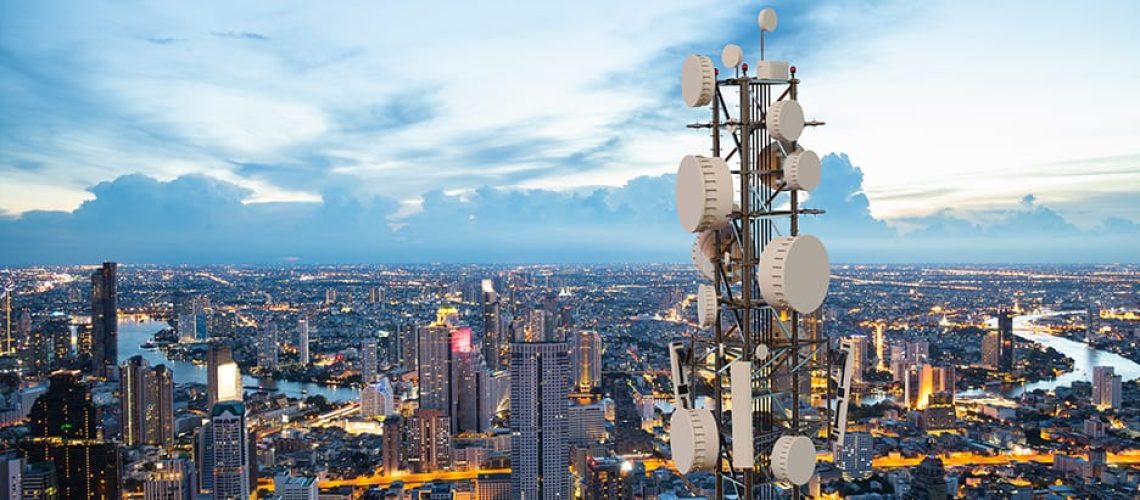IT TAKES TWO TO TANGO ON 5G
By David Hughes, Avionics News. Read the article on page 22 in Avionics News’ latest edition.
In the nation’s capital, things can go awry when federal agencies are still figuring out how to avoid radar altimeter interference as the big telecom companies roll out the latest in 5G cellphone technology. Former Federal Aviation Administrator Steve Dickson told the U.S. House Subcommittee on Aviation in February that the agency and aviation industry cautioned the Federal Communications Commission about possible 5G interference with radar altimeters in 2018 and supported related research efforts.
Dickson and the Department of Transportation asked the National Telecommunications & Information Administration in December 2020 to delay auctioning spectrum adjacent to where radar altimeters operate. The FAA urged the FCC to exercise caution and in December 2020 provided studies to back up its concerns on aviation safety. The auction went ahead, and Verizon and AT&T scheduled initial 5G deployment for December 2021.
When it became clear the new service would interfere with some radar altimeters of aircraft operating into airports near 5G towers, the FAA and Department of Transportation asked for and obtained relief. There were two pauses in which Verizon and AT&T kept some towers turned off.
The FAA received data from the wireless companies on transmitter location, power level and signal shape to conduct a safety assessment and set new standards for altimeter performance. Then in February, the FAA issued airworthiness directives revising landing requirements for a wide range of Boeing and Airbus aircraft. In the airworthiness directives, the FAA noted, for example, that several systems on a 737 rely on the radar altimeters including autothrottles, GPWS, thrust reversers and TCAS.
Dickson, who retired March 31 and was succeeded by Acting FAA Administrator Billy Nolen, believed that by working together in a collaborative way with industry, aviation and 5G can safely coexist. Another way to look at these issues is that the telecommunications companies acquired the spectrum from the FCC and are operating within the confines of the spectrum acquired.
“This is a typical classical radio engineering issue that hasn’t got a thing to do with 5G,” said Patrick Diamond, a telecom consultant who is a board member on the National Space-Based Position and Timing Advisory Board.
5G uses a number of bands that are 100 megahertz wide from the lowest frequency of 640 MHz to the highest that Verizon and AT&T use, which is millimeter-wave at 39 gigahertz. This high frequency is used on the network to transmit data bursts over short distances – only 35 to 40 feet apart. The telecom companies wanted these frequencies because they can carry a lot of data, thereby allowing 5G to download at 1 terabit per second.
Michael Koziol, IEEE Spectrum associate editor, wrote on Jan. 20 in an article titled “What you need to know about the FAA 5G kerfuffle (Why is 5G only a problem in the U.S.?)” that the area of concern is between 3.7 to 3.98 GHz. This is where 5G frequencies used by Verizon and AT&T may be too close to radar altimeters in the 4.2 to 4.4 GHz band. The FAA thinks this may be too close. According to Koziol, “Signals broadcast on frequencies that are similar (but not exact) to one another can still cause interference, although not as severe as if they were on the same frequency.”
Koziol, who has a degree in physics, noted, “This has been a uniquely U.S. problem. That’s because different countries allocate radio spectrum in different ways for different uses.” Then he added there isn’t much concern about radar altimeters in Europe because 5G there is using slightly lower frequencies from 3.4 to 3.8 GHz versus 3.7 to 3.98 in the United States. Meanwhile, Canada has created buffer zones.
Diamond maintains that radar altimeter antennas can pull in signals 400 MHz away from the area where they are licensed to operate. This is because when radar altimeters were designed
there weren’t many adjacent bands in use by anyone, and until 5G, only low power signals were using nearby spectrum.
By pulling in more signals, radar altimeter manufacturers could produce systems with higher performance. “If you design the antenna to receive signals at 3.8 GHz and your neighbor is transmitting at 3.8 GHz, you are going to receive that energy and it’s going to become interference,” Diamond said. ”The pulling range is too wide, so they need to narrow it, and that’s easily done with antennas and filters. None of this is magic; it is well-understood radio technology. Radar altimeter manufacturers have historically made receivers that can pull in the energy outside of the band they’re intended to operate in so they can maximize the receiver’s performance for customers.”
Diamond said U.S. telecom companies have a notch filter that prevents them from transmitting outside their authorized band, as they are tightly regulated. And in Europe, the
restrictions are even tighter than in the U.S. The spectrum released by the FCC for 5G is broader than it is in Europe, but the approved 5G band in the U.S. is still 400 MHz below the lowest authorized band of radar altimeters. So radar altimeters need to be redesigned and the filters need to be redone. “It is not the neighbor’s (5G providers) fault,” he noted.
There could be other frequencies affected in the future as the FCC auctions off other portions of the radio spectrum, and if it gets up to 5 GHz, this could affect weather radar. Those who assert that 5G frequencies are needed to keep the United States out in front on this important technology may be missing a key point. On Feb. 16, former Google CEO Eric Schmidt co-authored an op-ed article in the Wall Street Journal that points out America is far from ahead in a global move to 5G. He wrote that America’s average internet speed on 5G is a paltry 75 megabits per second on average, while China’s average is 300 Mbps and Korea is even farther ahead at 400 Mbps.
American 5G Mbps is about 10% to 20% lower than its 4G speed he noted, and while the U.S, government plans to invest $1.5 billion on 5G networks over the next four years, China will be boosting its total investment by $50 billion to $150 billion. The United States has 100,000 5G base stations versus China’s 1 million.
At the General Aviation Manufacturers Association’s state of the industry press conference in February, GAMA President Pete Bunce said the industry is still working on 5G mitigations for business aircraft and especially helicopters. When it comes to solutions, Bunce noted that Dickson has said “this is not going to be a quick process.” Bunce added, “We’ve got to be able to
certify our equipment, whether it’s with inline filters or whatever we are going to do, much like we do with ADS-B. And we have to put a lot of focus on being able to certify that to be able to find
solutions. We are all working toward that.”
“The worst case (for 5G interference) is really for helicopter operators, since it’s easy to limit the interference around airports with instrument landing systems, not so easy everywhere a medical helicopter may need to land,” said Andy Thurling, a former Air Force test pilot instructor and unit commander. He is chief technology officer at NUAIR, a nonprofit that conducts unmanned aircraft system flight tests in a 50-mile corridor between Griffiss Air Force Base and Syracuse, New York. NUAIR plans to use some parts of the 5G spectrum to control drones in flight tests.
When asked by Avionics News at the state of the industry press conference how the general aviation industry can avoid further inroads to aviation bandwidth by the communications industry, Bunce said, “We sure as heck better learn from this episode.” It may take legislative action or making sure the federal government is getting all of its resources together to talk to one another to avoid a problem because “it for sure will happen again as spectrum becomes even more precious.”
Phil Straub, who leads Garmin’s aviation business, spoke at the GAMA press conference and agreed with Bunce. “I think this (the 5G issue) has put a highlight on it, and the industry
will be more proactive going forward,” he said. “Once you have engineers on each side working together, and there is trust, there are amazing things that can happen. So we just need to learn from this experience and then do the right things going forward.”
Most radar altimeter designs have assumed the adjacent frequencies were protected. It is not until now that the protection cannot be assumed and that new designs would be needed to ensure radar altimeters “stay in their lane” as far as the use of the assigned frequency, according to Anthony Rios who is president of FreeFlight Systems of Irving, Texas. Rios has two decades of experience with aviation technology startup companies and is a computer engineer and a general aviation pilot with a commercial rating.
The solution has to be in the LRU, not just with the antenna. Just inserting a filter between the antenna and the LRU will require redesign of legacy radar altimeters, which he thinks might take 18 months to be TSO’ed, and that is a long time.
In 2019, FreeFlight started to design a new model of radar altimeter at a time when it looked like telecom companies might start transmitting at a higher power setting for 5G on
nearby frequencies. The company modeled 5G and how to counter interference into the new design to avoid that problem as much as possible.
The result was a new model, the RA 4500 Mark 2, which is a drop-in replacement with the same form, fit and function for the previous model RA 4500 introduced 15 years ago. FreeFlight also developed the Terrain Series RA 5500 and RA 6500 for use in Part 135 regional jet, business, general aviation, military, rotorcraft and unmanned aircraft. The company said the RA 5500 is designed for single installation, and the RA 6500 is designed for dual installation. Both are configured with digital signal processing to resist 5G interference.
Rios said a lot of regional jets, Part 29 helicopters and most heavier business jets require dual systems. Regional jet and EMS helicopter operators are showing a lot of interest in the RA 6500. In addition, the RA 5500’s weight of just 1.9 pounds and its 3.06-by-6.78-by-3.15-inch compact size has attracted the attention of unmanned aircraft companies. The Terrain Series units will be TSO certified by June and can be integrated with RAD-45 and other display indicators for accurate LED readings of AGL altitudes up to 2,500 feet. Terrain Series units can be retrofitted in legacy aircraft with existing antennas, control heads and cabling. An NVG display is also available.
FreeFlight’s new radar altimeters are about to receive a TSO so shipments can begin before June. Rios said the RA 4500 is currently installed on a lot of light helicopters such as Robinson, Bell, Airbus, and light airplanes, including Grob, Diamond, and Daher TBM where the drop-in replacement of the RA 4500 Mark 2 is drawing a lot of interest. FreeFlight has sold 5,000 of its legacy radar altimeters.
In the future, the company is eying additional software development and verification to address the market for Level A Part 121 narrow and wide-body airline aircraft. Rios noted the approvals for operations in areas with 5G towers near airports is only temporary.
All radar altimeters are susceptible to 5G interference, whether it is 10 miles from a 5G tower or 1 mile. FreeFlight’s new radar altimeters are good to within 0.1 mile of a 5G transmitter, and the FAA asked Verizon and AT&T not to allow 5G transmitters closer than a mile from the runway environment. “As of right now, our radar altimeter is not perfect, but our digital platform will continue to improve over time; 0.1 mile is good but not good enough. If you fly over a 5G tower, 0.1 mile is 500 feet vertically,” Rios said.
In Phoenix, Arizona, Honeywell takes the issue of possible 5G interference with its radar altimeters as a serious matter and is working with the FAA and aircraft manufacturers to
test its systems for 5G interference. Its radar altimeters meet all existing FAA and manufacturer certification requirements. If anything changes, the company said it will verify that its systems are compatible. In Scottsdale, Arizona, VIAVI Solutions provides test equipment that can help radar altimeter manufacturers and airline maintenance, repair and overhaul operations to check whether their equipment is susceptible to 5G interference. The company has been making the ALT-8000 for 10 years, which can test 90% of commercial radar altimeters and has a new testbed, the ALT-9000, which can test all radar altimeters on the market. This includes ones with low probability of intercept, combined radar altimeter and next-generation variants.
The ALT-9000 can be used with VIAVI’s testbed group of products to be externally exercised with VIAVI’s Ranger, which can inject custom-created RF signals or broadband recording of 5G signals into a test sequence. Then VIAVI’s OneAdvisor 800 can conduct real-time spectrum analysis with 2D and 3D spectrogram plots.
“At VIAVI, we have a unique current understanding about the potential interference in C-band, as we are deeply involved in both 5G communications and radar altimeter technologies,” said Sameh Yamany, VIAVI’s chief technology officer. This will help industry and government regulators tackle issues comprehensively to enable telecoms and aviation to operate in harmony.
VIAVI is getting a lot of interest in the ALT-9000 from the U.S. military, including Navy and Army test centers. “Right now, we are just trying to help all of our customers understand
any interference issues that may exist with 5G,” said Terry Jarboe, ALT-9000 business development manager.


